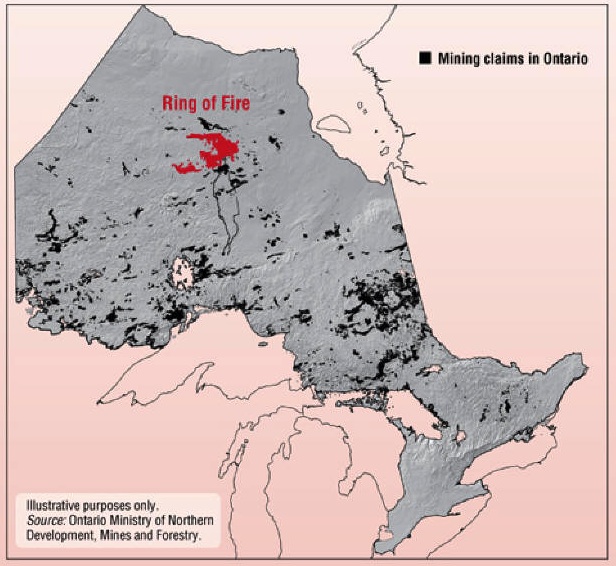
Ontario Parliament Building, Toronto by Pete Spiro.
The government of Ontario said Monday it is ready to allocate up to Cdn$1 billion to develop an all-season transportation corridor to the Ring of Fire and it is asking the Federal government to match the funds.
The funds would help build the necessary infrastructure to develop the mineral-rich deposit, which authorities say will create jobs and boost northern Ontario’s hard-hit economy.
The 4,000 sq kilometres Ring of Fire, located 540 km northeast of Thunder Bay, is home to rich mineral deposits, and lawmakers say it could bring prosperity to northern Ontario much like the oil sands industry have to northern Alberta. But the region lacks highways, rail lines or reliable power.

The Ring of Fire has mineral potential known to be worth $60 billion and includes the largest deposit of chromite, a key steel-making ingredient, ever discovered in North America.
US-based Cliffs Natural Resources (NYSE:CLF) had to suspend most work on its $3.3 billion Black Thor last summer, citing stalled talks with the province and other political and regulatory problems. The miner added it had struggled to win over aboriginal communities in the region.
Noront Resources Ltd. (TSXV:NOT), which holds the Eagle’s Nest and Blackbird mining projects, said the province’s commitment is a “vital milestone” that will benefit remote First Nations communities.
“Mining and the associated job creation can’t happen without infrastructure, so we are pleased to see the province make a clear public commitment to funding a transportation corridor in the Ring of Fire,” Noront president and CEO Alan Coutts said in a release.
Noront’s TSX Venture-listed shares went up by 9.1% to cents on Monday. Cliffs was down 3.7% at $17.33 on the New York Stock Exchange.
The Ring of Fire has mineral potential known to be worth $60 billion and includes the largest deposit of chromite, a key steel-making ingredient, ever discovered in North America.
The region also holds the potential for significant production of nickel, copper, gold and platinum.
Comments
Jason T.
I remembered that they had a problem deciding whether to build a railroad or highway for cars/trucks to the site. Either one or the other was the conflict, the company cited the costs were cheaper for the rail while the communities wanted a road. If they are still in conflict over this then they can build a hybrid. A railroad that can be built to have vehicles/trucks drive on it also. In Calgary the C-train moves over roads and vice/versa something similar can be designed there. Since vehicle traffic is limited to these remote areas it can be modified to be used for the amount of traffic forecasted for the region. ie less than traditional roadways in the province of Ontario. (A roadway about 2/3 the size of a roadway which will use less manpower to build and less materials. If a train is going to travel over it some of the hazards in an ordinary roadway can be avoided, like steep grades and turns.)
This a real opportunity here for the Governments of Canada to be world leader in infrastructure building and design. There are regions all over the world that can learn and build on from the project proposed in Ontario.
Google ‘anno globus’ and change the world